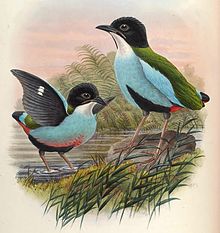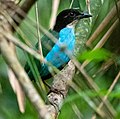| Azure-breasted pitta | |
|---|---|

| |
| ssp. coelestis | |

| |
| nominate subspecies | |
| Conservation status | |
 Vulnerable (IUCN 3.1) | |
| Scientific classification | |
| Domain: | Eukaryota |
| Kingdom: | Animalia |
| Phylum: | Chordata |
| Class: | Aves |
| Order: | Passeriformes |
| Family: | Pittidae |
| Genus: | Pitta |
| Species: | P. steerii |
| Binomial name | |
| Pitta steerii (Sharpe, 1876) | |
The azure-breasted pitta (Pitta steerii) is a species of bird in the family Pittidae. It is a striking and colorful bird having colors of red, azure, green, black and white, It is endemic to the islands of Mindanao, Bohol, Leyte and Samar in the Philippines. Along with the Whiskered pitta, it is one of two endemic pittas in the country. Its natural habitat is tropical moist lowland forest. It is threatened by habitat loss.
Description and taxonomy

EBird describes the bird as "A medium-sized, long-legged bird of lowland and foothill forest floor and undergrowth in the southern Philippines. Green on the back, with a black head and back of the neck, a pale blue wing with a black edge, pale blue underparts with a black patch on the belly, and red under the base of the tail. Similar to Hooded pitta especially if viewed from the back, but has a pale blue chest and a white throat. Song is a short series of medium-pitched barks, 'rak-rak-rak-rak-rak!'"
Subspecies
Two subspecies are recognized:
- P. s. steeri – Found on Mindanao; Darker and has a stronger green tinge
- P. s. coelestis – Found on Bohol, Leyte and Samar; Paler in colour
Ecology and behavior
Feeds on insects and worms. Forages on the ground, fallen logs and boulders, flicking over dead leaves with its bill.
Breeding basically unknown. On Bohol, most vocal active in April to June, which serves as the breeding season for a large majority of Philippine birds. Juveniles seen on Samar and Bohol in the months of Jun and July. Nest is still undescribed.
Habitat and conservation status
It is found in tropical moist lowland forest with dense understory up to 1,000 meters above sea level but more common below 600 meters. It prefers forests with limestone outcrops.
IUCN has assessed this bird as Vulnerable with the population being estimated at 2,500 to 9,999 mature individuals remaining. This species' main threat is habitat loss with wholesale clearance of forest habitats as a result of logging, agricultural conversion and mining activities occurring within the range. The most affected part of its range is Bohol which only has 4% forest cover remaining.
Occurs in a few protected areas in Rajah Sikatuna Protected Landscape in Bohol and Samar Island Natural Park but actual protection and enforcement from illegal logging and hunting are lax.
Conservation actions proposed are to do fieldwork and exploration to better understand its status and distribution. It's also recommended that its preference for limestone areas be further studied.
Gallery
-
 An illustration.
An illustration.
-
 ssp. steerii
ssp. steerii
-
 A specimen from the Naturalis Biodiversity Center
A specimen from the Naturalis Biodiversity Center
-
 ssp. steerii
ssp. steerii
References
- BirdLife International (2016). "Pitta steerii". IUCN Red List of Threatened Species. 2016: e.T22698644A93694792. doi:10.2305/IUCN.UK.2016-3.RLTS.T22698644A93694792.en. Retrieved 25 September 2021.
- "Azure-breasted Pitta". Ebird. Archived from the original on 2019-04-02.
- ^ Allen, Desmond (2020). Birds of the Philippines. Barcelona: Lynx and Birdlife Guides International. pp. 234–235.
- Erritzoe, Johannes (2020). "Azure-breasted Pitta (Pitta steerii), version 1.0". Birds of the World. doi:10.2173/bow.azbpit1.01. ISSN 2771-3105.
- Erritzoe, Johannes (2020). "Azure-breasted Pitta (Pitta steerii), version 1.0". Birds of the World. doi:10.2173/bow.azbpit1.01. ISSN 2771-3105.
External links
This Pittidae-related article is a stub. You can help Misplaced Pages by expanding it. |